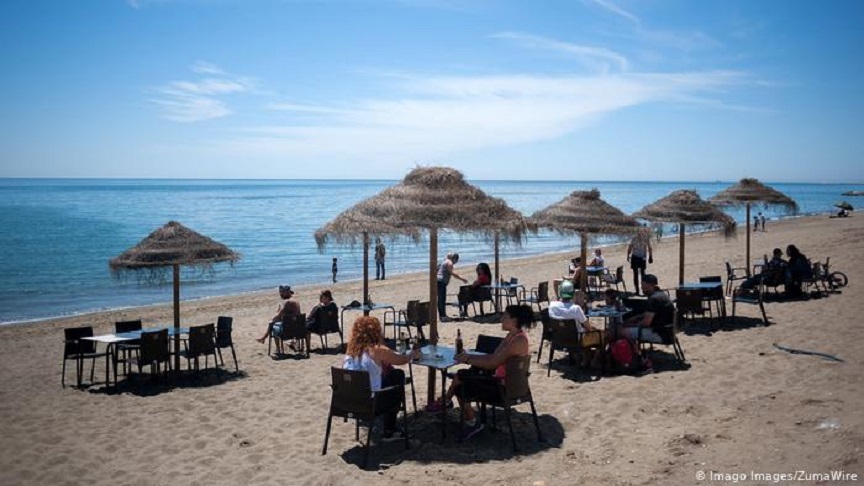The German government will vote on whether to lift its travel warning on 31 European countries by June 15. Italy’s foreign minister said the day that borders open again would be like another ‘D-Day’ for European tourism.
Germany wants to lift its travel warning on 31 European countries by June 15, if the development of pandemic figures allows for it, according to an official government proposal.
Those countries include 26 nations in the European Union, along with four Schengen Area countries that are not members of the EU — Iceland, Norway, Switzerland and Liechtenstein.
The proposal, listed in a paper called “Criteria for the Enabling of intra-European Tourism,” is set to be decided on in the cabinet on Wednesday.
German Foreign Minister Heiko Maas issued a global travel warning on March 17, as Germany headed into a nationwide partial lockdown. The lifting of the warning is set to come just in time for the holiday season, to allow for cross-border summer holidays within Europe.
The travel warning will be replaced by individual travel advice, which intends to highlight the risks for each individual country.
“The revitalization of tourism is important both for travelers and the German travel industry, as well as for the economic stability of the respective target countries,” the proposal says.
The possible lifting of travel restrictions was also welcomed by the German Travel Association.
“This not only gives companies in the travel industry a perspective [on the future], but also the many Germans who are looking forward to their [international] holidays,” said Nortbert Fiebig, the president of the association. The travel industry, with more than 11,000 travel agencies within Germany alone, has been one of the hardest hit by the coronavirus pandemic.
A coronavirus ‘D-Day’
Meanwhile, Italian Foreign Minister Luigi Di Maio on Tuesday called for a joint relaunch of European tourism in mid-June, referring to the day that borders open again as being a new “D-Day.”
“Let’s work together so that on June 15 Europe can start anew. June 15, is a day for tourism, a little bit like European D-Day,” Di Maio said in a television interview, referring to Germany’s draft paper to lift the worldwide travel warning.
“Germany is looking at a deadline of June 15 to reopen. We are working with Austria and we will work with other European countries,” he said.
Italy wants to open its borders to tourists on June 3, but it is still uncertain whether Austria will open its borders to Italy. Northern Italy was particularly hard-hit by the coronavirus pandemic, while Italy as a whole has recorded over 33,000 deaths from the virus so far.
Spain calls for renewed tourism
Spain has also called for renewed international tourism and a lifting of quarantine requirements for visitors from July 1. Spain — one of the world’s most visited countries — closed its borders and beaches in March, and was one of the hardest hit by the pandemic.
“The worst is behind us,” Foreign Minister Arancha Gonzalez Laya tweeted, with emojis of a bikini, sunglasses and a suitcase.
“In July we will gradually open Spain to international tourists, lift the quarantine, ensure the highest standards of health safety. We look forward 2 welcoming you!” she wrote.
Gonzalez Laya also said that EU member states should agree to a common approach when opening borders and reestablishing freedom of travel within the EU’s Schengen Area. Restarting cross-border travel should be decided collectively, even if countries are phasing out lockdowns at different dates, she told Cadena SER radio.
“We have to start working with our European partners to retake the freedom of movement in European territories,” she said, adding that Spain is eager to welcome tourists with a view to “health, sustainability and safety.”
Spain normally draws more than 80 million tourists per year, with travel accounting for over 12% of the country’s gross domestic product.
Europe begins to open up
Across the European Union, countries have been seeing more freedom on a domestic level. In Spain, Madrid and Barcelona emerged from one of the world’s strictest lockdowns, with parks and cafes open for the first time in more than two months. Beaches in other parts of Spain were also reopened, with strict guidelines for social distancing.
Meanwhile, gyms and swimming pools reopened in Germany, Iceland, Italy and Spain, while restaurants in Greece reopened for outdoor service.
Despite successful coronavirus restrictions across Europe, however, Sweden, which took a more lenient approach to the pandemic, saw its death toll exceed 4,000 — a figure much higher than that of its neighbors. The country gained international attention for its approach in not enforcing stay-at-home measures.
So far, over 5.5 million cases of coronavirus have been reported worldwide, while over 346,000 people have died of the virus.
DW / Balkantimes.press
Napomena o autorskim pravima: Dozvoljeno preuzimanje sadržaja isključivo uz navođenje linka prema stranici našeg portala sa koje je sadržaj preuzet. Stavovi izraženi u ovom tekstu autorovi su i ne odražavaju nužno uredničku politiku The Balkantimes Press.
Copyright Notice: It is allowed to download the content only by providing a link to the page of our portal from which the content was downloaded. The views expressed in this text are those of the authors and do not necessarily reflect the editorial policies of The Balkantimes Press.

